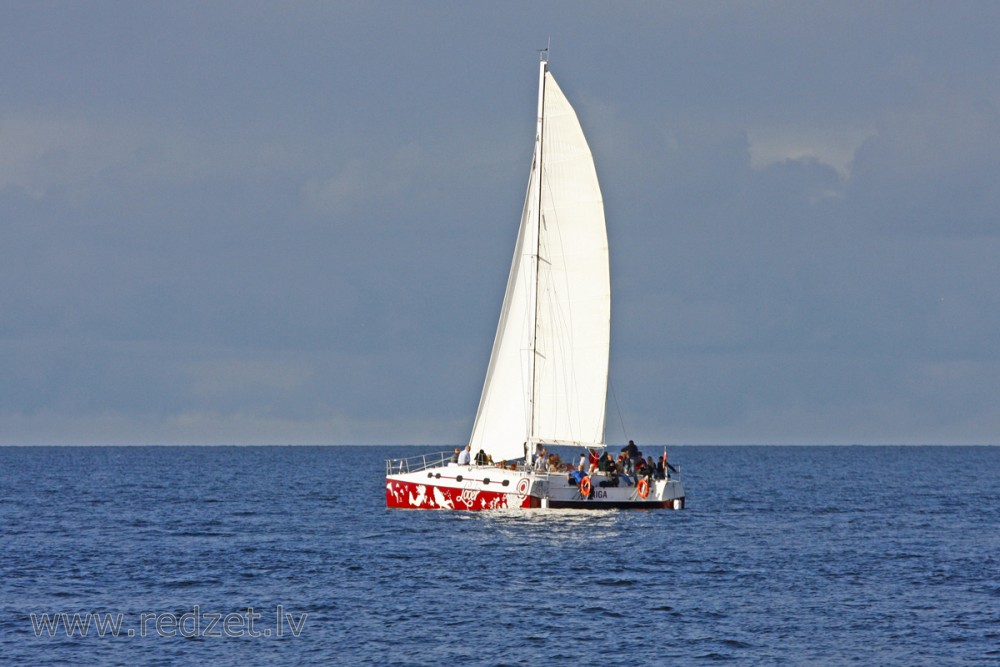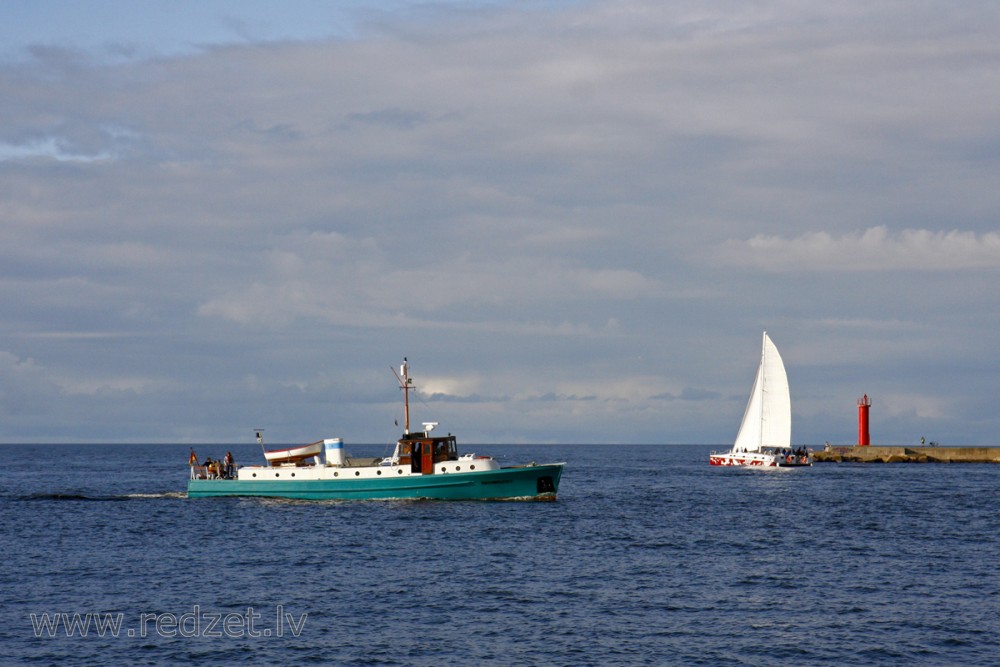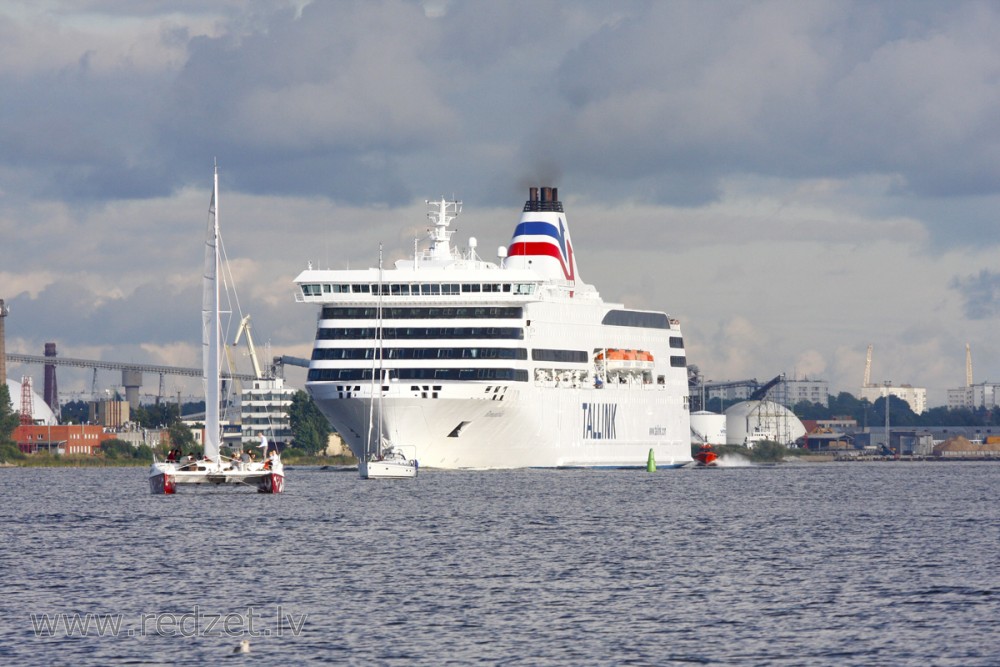Catamaran
A catamaran (/ˌkætəməˈræn/) (informally, a "cat") is a multi-hulled watercraft featuring two parallel hulls of equal size. It is a geometry-stabilized craft, deriving its stability from its wide beam, rather than from a ballasted keel as with a monohull sailboat. Catamaran is from a Tamil word "Kattumaram" which means logs tied together.
Catamarans typically have less hull volume, higher displacement, and shallower draft (draught) than monohulls of comparable length. The two hulls combined also often have a smaller hydrodynamic resistance than comparable monohulls, requiring less propulsive power from either sails or motors. The catamaran's wider stance on the water can reduce both heeling and wave-induced motion, as compared with a monohull, and can give reduced wakes.
Catamarans range in size from small (sailing or rowing vessels) to large (naval ships and car ferries). The structure connecting a catamaran's two hulls ranges from a simple frame strung with webbing to support the crew to a bridging superstructure incorporating extensive cabin and/or cargo space.
History
Catamarans from Polynesia and Maritime Southeast Asia became the inspiration for modern catamarans.
Polynesian and Asian catamarans
Catamaran-type vessels were first developed as early as 1500 BCE by the Polynesian peoples. These early examples were likely related to outrigger canoes and consisted of two canoes bound together with a wooden frame, sometimes accompanied by a sail. Despite their simplicity they were nonetheless effective, allowing seafaring Polynesians to voyage to distant Pacific islands.
Catamarans were seldom constructed in the West before the 19th century, but they were in wide use as early as the 5th century by the Tamil people of Tamil Nadu, South India. The word "catamaran" is derived from the Tamil word, kattumaram (கட்டுமரம்), which means "logs bound together." The 17th-century English adventurer and privateer William Dampier encountered the Tamil people of southeastern India during his first circumnavigation of the globe. He was the first to write in English about the watercraft he observed in use there. In his 1697 account of his trip, A New Voyage Round the World, he wrote,
On the coast of Malabar they call them Catamarans. These are but one Log, or two, sometimes of a sort of light Wood ... so small, that they carry but one Man, whose legs and breech are always in the Water.
Development of modern catamarans
The first documented example of double-hulled craft in Europe was designed by William Petty in 1662 to sail faster, in shallower waters, in lighter wind, and with fewer crew than other vessels of the time. However, the unusual design met with skepticism and was not a commercial success.
The design remained relatively unused in the West for almost 160 years until the early 19th-century, when the Englishman Mayflower F. Crisp built a two-hulled merchant ship in Rangoon, Burma. The ship was christened Original. Crisp described it as "a fast sailing fine sea boat; she traded during the monsoon between Rangoon and the Tenasserim Provinces for several years".
Later that century, the American Nathanael Herreshoff constructed a double-hulled sailing boat of his own design (US Pat. No. 189,459). The craft, Amaryllis, raced at her maiden regatta on June 22, 1876, and performed exceedingly well. Her debut demonstrated the distinct performance advantages afforded to catamarans over the standard monohulls. It was as a result of this event, the Centennial Regatta of the New York Yacht Club, that catamarans were barred from regular sailing classes, and this remained the case until the 1970s.
In 1936 Eric de Bisschop built a Polynesian "double canoe" in Hawaii and sailed it home to a hero's welcome in France. In 1939, he published his experiences in a book, Kaimiloa, which was translated into English in 1940.
The Prout Brothers, Roland and Francis, experimented with catamarans in 1949 and converted their 1935 boat factory in Canvey Island, Essex (England), to catamaran production in 1954. Their Shearwater catamarans won races easily against the monohulls. Yellow Bird, a 1956-built Shearwater, raced successfully by Francis Prout in the 1960s, is in the collection of the National Maritime Museum Cornwall.
In the mid-twentieth century, beachcats became a widespread category of sailing catamarans, owing to their ease of launching and mass production. In California, a maker of surfboards, Hobie Alter, produced the 250-pound (110 kg) Hobie 14 in 1967, and two years later the larger and even more successful Hobie 16. As of 2016, the Hobie 16 was still being produced with more than 100,000 having been manufactured.
The Tornado catamaran was designed by three Englishmen for a crew of two in 1967 as an Olympic catamaran candidate. At the Olympic Catamaran Trials of the International Yacht Racing Union, IYRU, it outperformed the other challengers for the role and was selected for the multihull discipline in the Olympic Games from 1976 through 2008. It was redesigned in 2000 and remains one of the fastest double-handed catamaran models.
Australia became the site of builders of large transport catamarans—Incat in 1977 and Austal in 1988 —each building civilian ferries and naval vessels.
The largest ship ever built in terms of gross tonnage, the Pioneering Spirit, incorporates a catamaran design.
en.wikipedia.org


